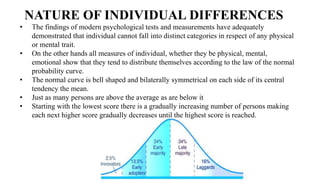Individual differences
- 2. OBJECTIVES • At the end of the unit, trainee students will be able to: • 1. Elaborate the meaning and nature of individual differences. • 2. Bifurcate the areas of individual differences. • 3. Identify the causes of individual differences. • 4. Provide remedial measures for individual differences through general educational provisions and special educational provisions. • 5. Take care of slow learners and finally be able to measure individual difference through various evaluation tests and techniques.
- 4. ∞‰¥«≤‘≥Ÿ‚Ķ
- 6. NATURE OF INDIVIDUAL DIFFERENCES • The findings of modern psychological tests and measurements have adequately demonstrated that individual cannot fall into distinct categories in respect of any physical or mental trait. • On the other hands all measures of individual, whether they be physical, mental, emotional show that they tend to distribute themselves according to the law of the normal probability curve. • The normal curve is bell shaped and bilaterally symmetrical on each side of its central tendency the mean. • Just as many persons are above the average as are below it • Starting with the lowest score there is a gradually increasing number of persons making each next higher score gradually decreases until the highest score is reached.
- 8. Areas of Individual Differences
- 26. Educational Provisions • Whatever may be the causes, children differ in their learning abilities. • It is the duty and responsibility of any school system to provide for these differences. • Every child is helped to rise at the height of his own abilities • The following are a few of the important steps that a school might take up in this direction • General Provisions • Special Provisions
- 27. General Provisions • Every Individual’s ability should be assessed as accurately as possible. • Identification of special talents • Educational provisions must be continuous • Adequate facilities and materials are needed • Competent school staff is needed • Individualization is necessary • Need of Adult Education
- 28. Special Provisions • Provisions For the Gifted / Talented Children • Educating the Gifted Children • Provisions for the Slow Learners • Identifying the Slow-Learner • Periodic Medical Examination • Learning Handicaps in exceptional Children • Placement with a Teacher • Avoid Competition • Remedial Teaching • Non-Promotion • A Disadvantaged Child
- 29. MEASUREMENT OF INDIVIDUAL DIFFERENCES • Measurement is the assignment of a number to an object or event according to rule. • This may represent something physical or a vocational aptitude test and receive your score in medical or engineering aptitude test. • In order to draw meaningful comparison, measurement, must be meaningful. • In order to have meaning, all measurements must satisfy two basic criteria: • Reliability • Validity
- 30. Test of General Intelligence • Tests of Aptitude • These tests measure the possibilities of success in future performance. • Measures the following abilities. (i) Verbal Reasoning (ii) Numerical Ability (iii) Abstract Reasoning (iv) Space Relations (v) Mechanical Reasoning (vi) Clerical Speed and Accuracy (vii) Language Usage
- 31. ∞‰¥«≤‘≥Ÿ‚Ķ ‚Ä¢ Interest Inventories ‚Ä¢ Interest inventories that can be used to measure differences among individuals in their interest. ‚Ä¢ Test of Personality ‚Ä¢ Used to measure personality structure and adjustment, and difficulties of individuals.
- 32. Competence-Based Tests ‚Ä¢ Multiple-Choice Tests or Essays ‚Ä¢ Computer Assisted Testing (CAT) ‚Ä¢ The Portfolio Approach ‚Ä¢ Grade Equivalent Scores ∞‰¥«≤‘≥Ÿ‚Ķ
- 33. • Virtually any curriculum that is more than five years old requires a thorough evaluation • This is most obvious in field such as science but should be done in all areas. • This type of testing shown answers the following: • (a) To what degree have the curriculum’s goals been reached? • (b) Is the curriculum content appropriate in view of the mission’s objectives. • (c) Has the instruction been truly based on the curriculum. • (d) Has the assessment measured the taught curriculum or planned. Curriculum Testing

































